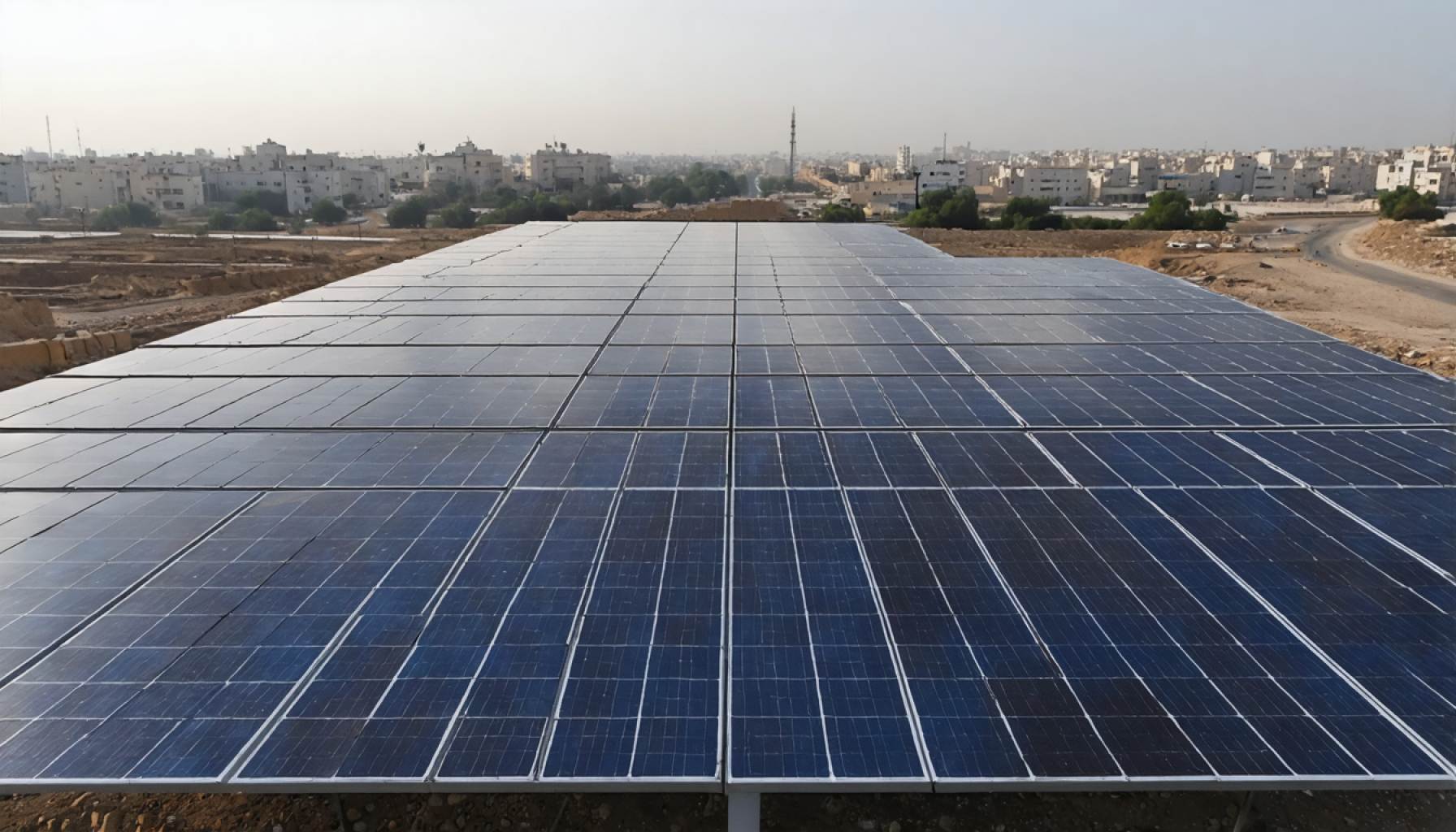- Majd Mashharawi, shocked by Tokyo’s brightness, contrasted it with energy-starved Gaza, highlighting deeper societal disparities.
- Gaza’s chronic electricity crisis is rooted in blockades from 2007, leading to severe daily power outages.
- Falling solar panel costs and Israeli approval allowed significant solar adoption, brightening Gaza’s energy landscape.
- Mashharawi’s Sunbox initiative brought solar solutions to households and essential infrastructure, advancing Gaza’s resilience.
- October 2023 military conflict wrought physical and personal losses, yet solar solutions became vital lifelines for Gazans.
- Despite destruction, Gazan resourcefulness thrived—utilizing salvaged solar panels to meet essential energy needs.
- Global aid via UN and World Bank seeks to sustain solar integration, envisioning a resilient, self-sufficient Gaza.
- Gaza’s story underscores the importance of perseverance and the transformative power of clean energy.
Majd Mashharawi’s eyes opened wide as her plane descended into Tokyo’s shimmering lights in 2017—the moment crystallizing in disbelief at a life so different from her electricity-starved native Gaza. Raised in a city where power flickers for mere hours daily, Mashharawi perceived the scale of discrepancy: an illumination of privilege versus the obscurity back home.
The electricity crisis in Gaza tracks back through a tangled history with Israel—a legacy of blockades initiated in 2007, limiting the flow of vital resources, including the energy-producing fuel and materials for infrastructure. Quickly became evident: energy control became leverage over the Hamas-controlled region. For Gazans, it seeded an era of energy poverty, translating to grueling daily power outages, averaging 12 to 16 hours, marked by frustrating unpredictability that stunted potential and reshaped daily life.
In a twist of happenstance, falling global costs for solar panels in recent years shone a hopeful light into Gaza. Recognizing a strategic advantage, Israeli approval in 2016–2017 allowed the entry of approximately 100,000 solar panels, sparking a renewable disruption. Panels began to sprout on rooftops and desolate communal spaces, especially in crowded locales like refugee camps. Suddenly, a new dawn was conceivable: solar energy as a sliver of independence amidst political dysfunction.
Mashharawi, driven by determination, seized this opportunity to catalyze significant change. The inspiration came not just from her struggle but from witnessing thriving lives during her travels. Founding Sunbox in 2017, her company created access to solar solutions, empowering families and revitalizing businesses. From household units to large-scale projects, Sunbox infused Gaza’s fabric with renewable lifeblood. The initiative empowered essential infrastructure, like desalination plants and streetlights, giving young girls a safe passage to education.
Events of October 2023, a military assault on Gaza, inflicted deep wounds. Amid her service abroad, Mashharawi could only watch as Sunbox’s physical presence crumbled, symbolizing the tangible and personal losses etched into Gaza’s hardship. Yet, the solar revolution endured. Now, amidst destruction, Gazans transformed solar solutions into lifelines, scavenging usable panels to fuel daily resilience.
In makeshift markets, solar panels and peripherals exchange hands. Even amid chaos, resourcefulness prevails—solar panels precariously perched against walls and furniture, sunward-reaching to harvest every available ray. The scene embodies Gazan fortitude: ingenuity as a shield against darkness.
Globally, aid organizations like the UN and World Bank rally efforts to infuse fresh hope, channeling their support into solar integration—an attempt to craft a cornerstone for recovery. They envision a self-sufficient Gaza of the future, wired with solar energy, powering homes and restoring livelihoods.
This relentless pursuit of light amidst adversity offers a critical lesson. Gaza’s situation demands attention—not just to end unyielding suffering but to acknowledge the tenacity of collective human spirit. As reconstruction dialogues unfold, from sovereign states to international allies, competition amplifies over visions of Gaza’s future framework—a clean energy haven rising from ruins.
Mashharawi’s efforts echo in the winds sweeping across her homeland: a testament that even in the deepest shadows, the world can turn to the sun.
The Solar Revolution in Gaza: How Innovation and Resilience Are Powering a Brighter Future
Overview
Majd Mashharawi’s journey from the electricity-starved Gaza to the illuminated streets of Tokyo was a turning point, highlighting the stark contrast between privilege and deprivation. Gaza’s electricity crisis, rooted in historical blockades and political tension with Israel, has left its citizens grappling with daily power outages lasting up to 16 hours. Yet, amidst adversity, an opportunity emerged—solar energy became a beacon of hope.
The Solar Energy Shift: Making the Most of Technological Advancements
Global Solar Price Drops: The global decline in solar panel costs around 2016–2017 allowed for a feasible energy alternative in Gaza. This change facilitated the entry of around 100,000 panels into the region. According to the International Renewable Energy Agency (IRENA), solar energy costs have dropped by approximately 82% between 2010 and 2019, making it more accessible to energy-starved regions like Gaza.
Sunbox Initiative: Founded by Majd Mashharawi in 2017, Sunbox capitalized on solar energy to transform Gaza’s power landscape. The company offered solar solutions ranging from individual household units to large community projects. These initiatives powered essential infrastructure, such as desalination plants and streetlights, creating safer environments for children, particularly young girls, en route to school.
Recent Developments and Challenges
October 2023 Assault on Gaza: The conflict severely damaged infrastructure, including solar installations by Sunbox. Despite the physical loss, the enduring spirit of Gazans has led them to creatively repurpose remaining solar panels to meet everyday needs, underscoring resourcefulness in times of crisis.
Solar Market Trends and Future Predictions: As Gaza rebuilds, the demand for solar technology is anticipated to rise. Analysts predict that the global solar market will grow at a compound annual growth rate (CAGR) of 20.5% from 2021 to 2028 (source: Allied Market Research). This growth, coupled with international aid, can potentially stimulate Gaza’s recovery and energy independence.
Pressing Questions Answered
What are the limitations of solar energy in Gaza?
– Intermittency: Solar power is dependent on sunlight, making it less reliable during cloudy days and nighttime. This is a significant limitation but can be mitigated with battery storage systems.
– Space Constraints: Dense urban settings and refugee camps have limited available space for solar installations.
– Political Instability: Ongoing conflicts pose a risk to the long-term sustainability of solar infrastructure.
How do international organizations contribute to the solar initiative in Gaza?
– Organizations like the UN and World Bank are investing in solar energy projects to aid reconstruction efforts. They strive to create sustainable, long-term energy solutions, fostering economic stability and reducing dependence on external power sources.
Actionable Recommendations
– Invest in Hybrid Systems: Combining solar with other renewable technologies could provide more consistent power. Gazans should explore hybrid systems and battery storage solutions to store solar energy for use during non-sunny periods.
– Community Solar Projects: Establishing community-focused solar projects can maximize the collective benefits of solar energy and distribute cost among numerous stakeholders.
– Engage International Support: Continued advocacy for international support and investment is crucial. Engaging global aid, technology, and expertise can accelerate solar adoption and infrastructure rebuilding.
Quick Tips for Incorporating Solar Energy
– Homeowners should explore rooftop solar options that complement existing power sources.
– Businesses can reduce overheads by implementing solar solutions, potentially benefiting from international funding or subsidies.
– Local Leaders are encouraged to support solar education programs, promoting awareness and skills necessary for maintaining and advancing solar technologies.
For more information on renewable energy and sustainable initiatives, visit United Nations.
In conclusion, the pursuit of light in Gaza embodies a global lesson in resilience and innovation. Despite adversity, the transition towards solar energy represents a pivotal shift towards self-sufficiency and empowerment—a testament to human spirit and ingenuity.















